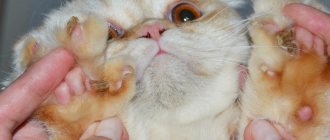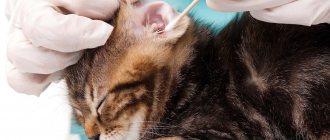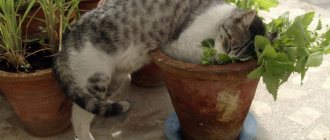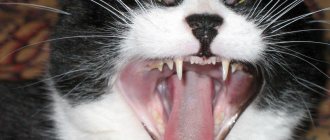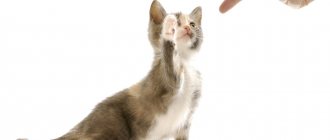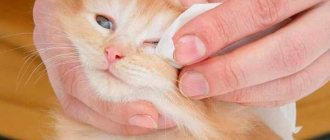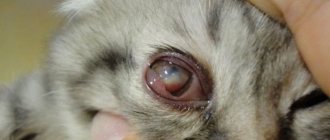12720Pavel
1
If you notice that your cat is squinting one eye, this may mean that the animal has a serious illness. Squinting of one eye is an alarming symptom indicating pain and discomfort in the pet's eye. Often, closing the eye is accompanied by profuse lacrimation or even suppuration. At this stage, it is important to immediately understand the causes of this condition in the cat and take all necessary therapeutic measures.
Causes
It should be noted right away: in most ophthalmological diseases of cats and humans, the pathogens are the same. Therefore, after touching your pet's eyes, you should wash your hands with special care.
Squinting indicates that the animal is experiencing pain or discomfort, which is caused by the following reasons:
- infectious diseases;
- injuries;
- inflammation of the third eyelid;
- glaucoma.
Clinical symptoms, diagnostic methods, treatment and prevention vary depending on the cause. Therefore, each disease is described in a separate section.
Why is a kitten born with its eyes closed?
The living conditions of the ancestors of modern cats in the wild were not conducive to long-term gestation. Therefore, kittens were born premature, blind and deaf. Compared to the young of other species, of course.
The second reason for blindness is the protection of the unformed organism from the penetration of microbes and other unfavorable factors. The cornea of the eye is the gateway to the bloodstream. Cubs need time to obtain antibodies to pathogens from maternal colostrum so that the immune system is prepared to repel microbial aggression.
But the cat does not have time to nurse the kittens for a long time. To feed her offspring, she needs to hunt, then there will be enough milk. Therefore, the development of children in the external environment proceeds at an accelerated pace.
Contagious diseases
Damage to one eye is typical for the following infectious diseases:
- herpes;
- chlamydia;
- demodicosis;
Herpes
Blepharospasm
A viral disease better known as rhinotracheitis. An acute course is typical for unvaccinated kittens from two to three months. Chronic disease occurs in adult animals during periods of weakened immunity. At the initial stage, blepharitis develops, which is characterized by inflammation of the eyelids. They stick together and blepharospasm develops.
Subsequently, the second organ of vision is also affected. A characteristic sign of rhinotracheitis is ulcers on the cornea of the eye. Self-medication is dangerous because it can cause loss of one or both eyes, bronchopneumonia, constipation, and damage to internal organs. Treatment is prescribed by a veterinarian. To prevent rhinotracheitis, kittens and sexual partners are vaccinated before mating.
Chlamydia
The bacterial infection primarily affects kittens from 1 to 3 months. At this time, death is possible. With chlamydia, one eye first becomes inflamed, then the second is affected.
Be sure to read:
A cat’s teeth are falling out: physiological and pathological reasons, what to do, prevention
With chlamydia, one eye is affected first.
Treatment is prescribed by a veterinarian. If ophthalmic ointments or drops are used, two eyes should be treated, even though one of them looks healthy. Prevention consists of proper feeding, satisfactory living conditions and vaccination with a polyvalent drug against chlamydia and other dangerous diseases of cats.
Demodicosis
Demodicosis glasses
The pathological process is caused by the activation of the subcutaneous mite due to a weakening of the immune defense. With asymmetrical lesions, demodectic glasses are formed around one of the eyes. Soreness causes the pet to squint one eye.
Treatment consists of treating the affected surface with external insecticidal and acaricidal agents. If the pathological process goes far, inflammation occurs.
As the affected area heals, it scars and squinting becomes a lifelong cosmetic defect. Prevention consists of proper feeding, as well as applying insecto-acaricidal drops Spot on to the healthy, intact skin of the withers, which protect the pet from fleas, helminths, cutaneous and subcutaneous ticks.
Causes of squinting eyes in cats
The cat's eye is an incredibly sensitive organ, so quite often it can be susceptible to inflammatory processes and the development of various pathologies. Many diseases can manifest themselves in this way when cats squint their eyes.
© shutterstock
Let's take a closer look at the reasons for this phenomenon.:
- The presence of conjunctivitis is an inflammatory lesion of the mucous membrane of the eye. The disease is accompanied by swelling of the eyelids, mucous and purulent discharge. The affected eye becomes red and itchy, and a bluish or white cloudiness may also appear on it. To treat pathology, special eye drops are used, and rinsing procedures are also carried out. In later stages of the disease, antibiotic injections may be prescribed.
- Corneal erosion is damage to the cornea of the eye. An equally common reason why a cat squints one eye. The causes of the development of the disease are viral infections, injuries, burns, and glaucoma. Untimely treatment leads to the formation of a serious pathology - a corneal ulcer.
- Mechanical injuries to the cornea , which are always accompanied by severe pain and, as a result, the cat begins to squint its eyes. The insidiousness of such injuries lies in the penetration of pathogenic microorganisms into the depths of the tissues of the eye, where they further multiply. You should be especially careful about eye injuries caused by cat claws, since a large number of dangerous bacteria and worm eggs accumulate under them.
- An increase in eye pressure , which occurs due to age-related changes and the old age of the animal, is also a possible reason that the cat squints the visual organ. Due to the lack of proper treatment, this condition can predispose the cat to the development of one-sided blindness.
- Allergic reactions to flowers and plants , dust and household chemicals often cause a kitten to squint its eyes. A veterinarian will help identify the causative agent of the allergy and prescribe appropriate medications.
Injuries
Unilateral damage most often occurs in a fight, and also occurs when a cat is stung by a bee. One side swells and the eye closes. A pet injures its eye while chasing prey, or when a splinter gets into the soft tissue or a small solid particle gets into it. Ophthalmic drops are used for treatment.
If the use of an external remedy does not lead to the desired results. Seek veterinary help.
Inflammation of the third eyelid
The nictitating membrane in an active cat is invisible. The transparent membrane protects the eye sphere from dust particles and debris. Due to the inflammatory process, the membrane hypertrophies and no longer fits under the eyelids.
Most often, unilateral inflammation is observed due to the following reasons:
- infectious diseases;
- allergic reactions;
- injuries;
- internal non-communicable diseases;
- congenital predisposition.
Most often, Persians, Britons, as well as mixed breeds and cats of related breeds get sick. Treatment is surgery. To prevent inflammation of the eyelid, you should purchase a pet from trusted breeders and not engage in spontaneous selection.
Be sure to read:
A cat has an earache: causes, how to understand, symptoms, first aid, what to do at home
When do kittens' eyes open after birth?
The first seven days for babies are spent in silence and darkness. During this period, babies should eat and sleep. To do this, they must not see or hear anything. On average, the opening of the eyes occurs in the second week of life. However, most cat breeds were bred by humans with specified properties, so the timing of eye opening and other development criteria changed along with the genotype.
Be sure to read:
Cats have mats, what they are + video on how to get rid of hair that has gotten into a ball
Regardless of the breed, the following patterns exist regarding the timing of maturation:
- the kitten born first opens its eyes earlier than others;
- in animals with short hair, the eyes open earlier than in long-haired animals;
- kitties gain sight faster than seals;
- kittens from older cats open their eyes earlier;
- There is an inverse relationship between the duration of pregnancy and the timing of maturation of the cubs.
Features of discovery according to breed
According to the timing of eye opening in baby cat breeds, they are arranged in the following order:
- Sphynxes: kittens open their eyes on the third day of life, some individuals are born sighted.
- Thais and Siamese begin to see the light at 3-6 years of age.
- Kittens of the Siberian breed open their eyes on the 5-7th day of life, British kittens a day later.
- In Scottish kitties, the eyelids open slightly on the fifth day, but the process varies in duration and ends at the end of the second week of life.
- Maine Coons and Ragdolls begin to see the light no earlier than the middle of the second ten days.
How do eyelids open?
The first cracks appear on the side facing the nose. The lumen gradually increases, however, full disclosure can take from several days to 10 days.
All kittens' eyes are initially dull blue and at this moment the animal only reacts to light and distinguishes the silhouettes of objects. At this time, bright lighting is harmful for him, however, the mother cat knows better how to care for the cubs.
Glaucoma
Glaucoma
Elderly pets suffer from numerous chronic diseases, against the background of which eye pathologies develop. With glaucoma, intraocular pressure increases. The affected organ becomes sensitive to the slightest irritation. The cat develops photophobia: bright light causes the affected eye to squint.
Congenital glaucoma is observed in Persian, Siamese and British kittens. The development of the pathological process can be slowed down if the underlying disease is treated. Full recovery is impossible. Conservative treatment is aimed at relieving pain. If pathological signs increase, surgery is performed. Most often, the damaged organ is removed.
Glaucoma in a kitten
Prevention of congenital diseases involves excluding parents of sick kittens from breeding. Thoroughbred young animals should be purchased from trusted breeders who value their reputation.
Chronic diseases of older animals are prevented by compliance with housing and feeding standards, timely deworming and treatment against external parasites.
Prevention
It is easier to prevent a disease than to treat it. It would seem like such a hackneyed phrase. But how accurate is it? Instead of spending large sums on treating your pet, follow these tips to prevent eye diseases:
- All discharge is removed daily with a damp cotton swab. You can moisten it either in water or in chamomile infusion, for example.
- If your pet develops “tear tracks,” they are removed with a cotton swab, preventing them from drying out near the eyes.
- Did you have to bathe your cat? Be careful not to get shampoo into your eyes. Otherwise, a chemical burn cannot be ruled out.
- If your cat has long hair, you need to be careful not to let it get into your eyes. Some owners trim the hair above the eyes.


